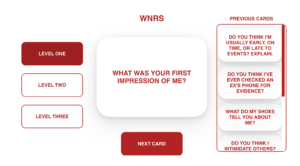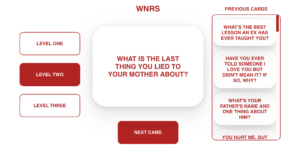For this critical play, I played the getting to know you game: We’re Not Really Strangers. While ‘strangers’ is in its title, the game is quite diverse in its audience. It sounds impossible, but the game is playable with nearly every single adult. The only exclusion would perhaps be children of a young age who haven’t fully formed their identity yet. Despite its mass appeal, everyone playing must be willing to share intimate things about themselves (a natural outcome from the card prompts). In this sense, the game could be played with strangers to help make that initial connection that goes beyond a first impression or played with friends to help the group get deeper. With this, We’re Not Really Strangers requires a high level of vulnerability to enjoy the merits of the game. It also encourages player interaction through its thoughtful level design with its card prompts.
I came to these conclusions upon playing the game with one of my group members, a friend, and a stranger through an online version. The great success of We’re Not Really Strangers can be attributed to its level design. Giving a simple act of ‘getting to know someone’ a structured sense of progression, meant that there were clear norms established at each level that signaled the vulnerability of players, their answers, and the reactions to those answers.
Level 1 started with Perception, or first impressions. This works well when playing with both strangers and friends (especially if the topic of first impressions has never come up before). In this sense, I experienced the perception level in 3 contrasting fields of familiarity, a person who I was somewhat familiar with (my group mate who I did not know before the class), my friend (whom I’ve known since freshman year), and the stranger (a friend of my groupmate). This same level of familiarity can be applied to all the players playing at that time. In this sense, perception allows everyone to warm up to one another. First impressions were made with a question as simple as: ‘What was your first impression of me?’, alongside others. The prompts on these cards were also directed at everyone else. This meant the person drawing the card was able to learn what others thought about them.

Level 2’s theme was Connection. The aim of this one was to go beyond the first impressions and allow the player who draws the card to share about themselves. This meant that now everyone else was listening and reacting instead of answering. It also deepens the level of vulnerability needed as the card prompts become more intimate. While fairly successful in my playthrough, there were a few moments of hiccup. The stranger that I played with received the card: ‘What is the last thing you lied to your mother about?’ He thought for a long time, but couldn’t come to an answer and he drew a different card. I have no way of verifying if this was real or if he was just too uncomfortable to share. In this sense, there is a silent mutual understanding of honesty presented in these answers.

Level 3 finished it off with Reflection. The card prompts returned to the format of that of the first one where the questions were directed outwards toward the group. In this way, the overall progression of the game loosely mimics a real conversation between two individuals where I talk then you talk. With this, a sense of intimacy is baked into the mechanics of the game. This last level of cards also goes a layer deeper while allowing for flexibility in the seriousness of answers. Questions such as ‘If we were in a band, what would our name be?’ or ‘What would be the perfect gift for me?’ eased up the tension that was built from the high-emotion driving questions of level 2. Other questions from this final level still allowed for a strong sense of vulnerability if wanted; ‘What would make you feel closer to me?’ and ‘What question were you most afraid to answer?’ are examples of this. This final release of tension feels like a sigh of relief or the sense of pleasure derived from achieving a difficult task (the harder questions of level 2).
Ultimately, this game is (probably) the most successful one at achieving the goal of getting to know someone. Its layered level design and division of card prompts makes the entire process feel seamless despite the movement of one level to the next being brute forced. In relation to the game that my group is designing (Last Man Dancing), we also implemented a level design of our own. While our main goal isn’t to help one another get to know each other better, it’s still achieved through the varying difficulty of prompts allowing players to exercise their bodies creatively. The mechanic that gets at achieving this the most is the cards that force players to break the physical barrier. Cards that encourage you to dance with the person to your left or to do a dance battle helps players engage in more ways and grow closer together. While not perfect, I believe we have a lot of room to grow and can look towards We’re Not Really Strangers’ amazing level design for inspiration.




